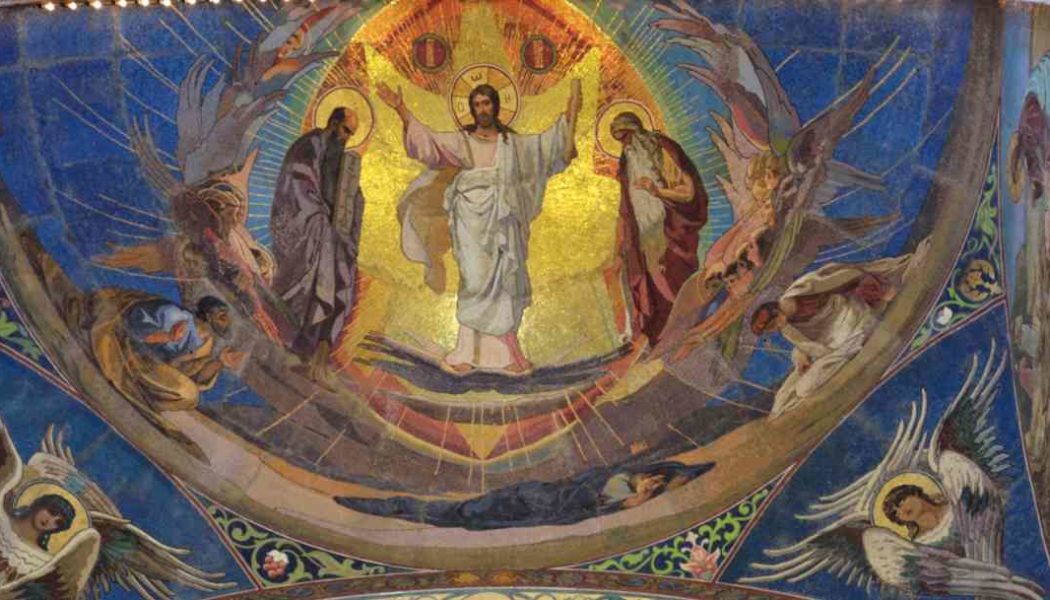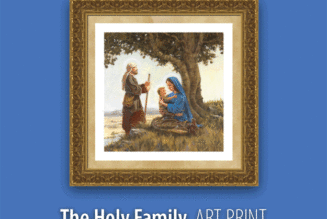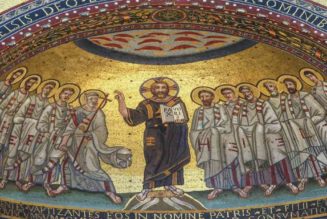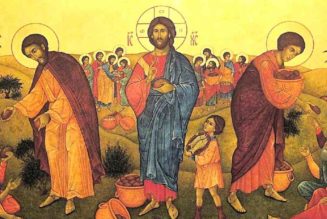
The Church presents us with the spectacular story of the Transfiguration on the Second Sunday of Lent Year B for the same reason Jesus presented the transfiguration to the first apostles 2,000 years ago.
It is immensely clarifying of the point of Lent and, in fact, our entire earthly existence, from the beginning to the end of time.
In the Gospel of Mark, the Transfiguration happens just one week after Jesus announced he would die and rise.
When Jesus tells the apostles that he will die and rise again, exactly halfway through the Gospel of Mark, the apostles are taken totally off guard and don’t know how to process it. In many ways, the Resurrection was the biggest surprise: Isaiah predicted, directly, that a Suffering Servant messiah would come and endure pain and torture for us. But he doesn’t predict the Resurrection with the same kind of specificity.
So Jesus does something brilliant in the Transfiguration: He both shows what the resurrection will look like, and reveals that it is something God has been preparing for us all along.
What will the resurrection look like? St. Bede says Jesus’s appearance points “to the church of his saints” who “at the time of the resurrection will be purified from every blemish.” Or, as St. Thomas Aquinas put it, at the end of time, “He will reform the body of our lowness configured to the body of his glory.”
Meanwhile, just showing Moses and Elijah with him tells us several things: First, that human beings don’t end at death; and second, that human bodies continue to be important after death. It is also an indication that heaven is something that not everyone necessarily achieves. These are two of the great heroes of the Old Testament with Jesus, after all.
In fact, these are very specific figures: Moses, who led the first Exodus and received the Ten Commandments, represents the Law. Elijah, who defeated the priests of Baal, represents the prophets. It is also instructive that of these two figures, the body of one was never found and the body of the other was seen being carried to heaven on a chariot. Through Moses, the Passover spared Hebrew lives from the angel of death; Elijah raised a widow’s son from the dead.
By showing these two now in heaven, with recognizable bodies, God shows where the path of the Law and Prophets was always meant to lead: To bodily existence for eternity.
But these aren’t the only Old Testament figures of the resurrection we hear about at Mass this Sunday.
The first reading is the famous story where God tells Abraham, “Take your son Isaac, your only one, whom you love … you shall offer him up as a holocaust on a height I will point out to you.”
Abraham is ready to obey, and does so — until God’s messenger, at the last minute, says, “Do not lay a hand on the boy. Do not do the least thing to him. I know now how devoted you are to God.”
The symbolism in the story that applies to Jesus Christ is well known.
- Abraham doesn’t end up sacrificing his son on Mount Moriah. But God the Father sacrifices his own Son on Calvary.
- Isaac carries the wood for his sacrifice himself, just like Jesus carried his cross for us.
- Abraham says “God will provide the lamb” for his sacrifice — but God provides a ram. Theologians suggest that God did eventually supply the sacrificial lamb — Jesus.
But the New Testament and Fathers of the Church point out that this story doesn’t just predict the passion and death of Jesus, but his resurrection too.
Before Abraham went up the hill, he said to his servants: “Stay here with the donkey, while the boy and I go on over there. We will worship and then come back to you.”
That promise that “we” will come back is meaningful. Abraham knows that he has been promised by God that “Through Isaac descendants shall bear your name,” and so, says the Book of Hebrews, “He reasoned that God was able to raise even from the dead.” So he fully expected that, even if he had to sacrifice his son, both would come back.
So, from the dawn of the story of the Chosen People, resurrection hovers in the background.
But there are other preparations for the Resurrection in Scripture.
In Wednesday’s Mass readings, we heard how Jesus said “this generation” seeks a sign, “but no sign will be given it, except the sign of Jonah.”
Brant Pitre in his book The Case for Jesus shares a “true confession”: He never really liked that Jesus said that. The “Jonah in the belly of a whale” story is one of those Biblical tales that seems to be more metaphorical than literal.
But then he noticed something. “The book never claims Jonah remained alive for three days and three nights in the fish,” he said. “It pretty explicitly says that Jonah died and went to the realm of the dead.”
The book says Jonah went to the “belly of Sheol … whose bars closed upon me forever.” Then, after Jonah’s body was deposited on the shore God said the same word to Jonah that Jesus used to raise a girl from the dead: “Koum,” which we translate “Arise.” And Jonah came back from his “forever” end.
But Christians celebrate many resurrection prophecies. My favorite is the fact that in the Genesis account, plants grew on earth on the third day. Jesus compares his own death and resurrection to the cyclical lifespan of plants. They shows resurrection built into the very creation of the world.
We exist for dying and rising, thanks to the love of the Father and the fidelity of the Son.
The Church puts these stories at the very beginning of Lent so that we can use the whole season to increase our faith.
In the Transfiguration reading, the voice of the Father says, “This is my beloved Son. Listen to him.” He doesn’t say, “These are my beloved sons” about Moses and Elijah and Jesus — he says “This is my beloved son.” It is clear that Jesus is something greater than the greatest heroes in Scripture.
And if we “listen to him” what do we hear?
This Sunday, we hear: “This is my body which will be given up for you,” and “this is my blood … poured out for you.” Then we receive him looking like wheat that has been crushed and made into bread, and receive him, the seed of immortality, into our bodies so that he can recapitulate his resurrected life in our lives.
He invites us to join him in his great self-gift to the Father. But without the Resurrection, I wouldn’t go near him. It’s the fact that he rose from the dead that makes “dying with Christ” a pathway to new life with our Lord and friend instead of a nihilistic self-immolation.
Peter, James and John forgot about the transfiguration during Holy Week, but we shouldn’t. These readings are meant to give us at the beginning of Lent the faith we will need in the end. As St. Paul puts it in the Second Reading:
“If God is for us, who can be against us? He who did not spare his own Son, but handed him over for us all, how will he not also give us everything else along with him?”
Believe it: He always has and he always will.








